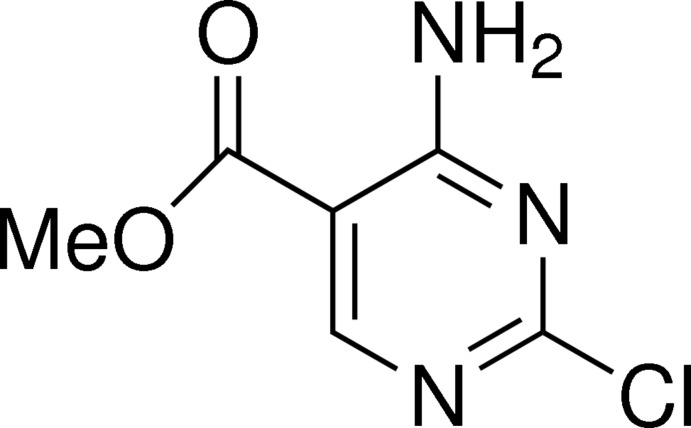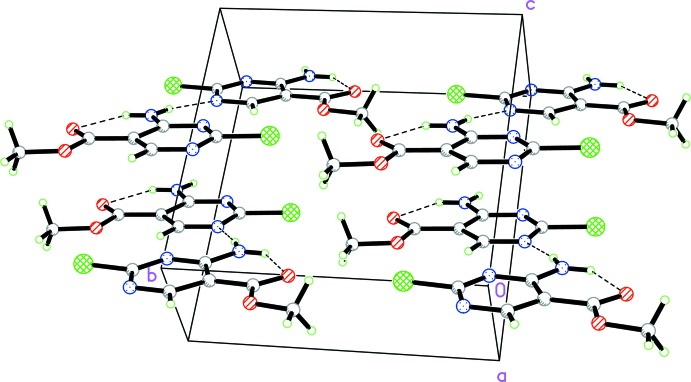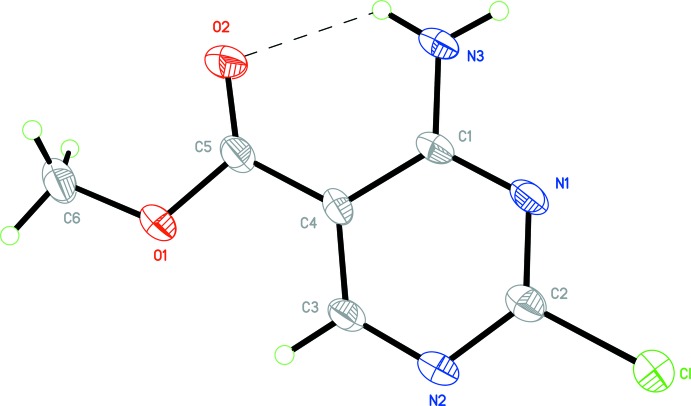Abstract
In the title compound, C6H6ClN3O2, all non-H atoms are approximately coplanar [maximum deviation = 0.012 (4) Å]; an intramolecular N—H⋯O hydrogen bond occurs between the amino group and the carbonyl group. In the crystal, molecules are linked by N—H⋯N hydrogen bonds into supramolecular chains propagated along [101].
Keywords: crystal structure
Related literature
For related structures, see: He & Kang (2006 ▶); He et al. (2007 ▶). For the synthesis, see: Ballard & Johnson (1942 ▶).
Experimental
Crystal data
C6H6ClN3O2
M r = 187.59
Monoclinic,

a = 3.9110 (8) Å
b = 10.136 (2) Å
c = 9.848 (2) Å
β = 98.71 (3)°
V = 385.89 (13) Å3
Z = 2
Mo Kα radiation
μ = 0.45 mm−1
T = 293 K
0.20 × 0.20 × 0.15 mm
Data collection
Enraf–Nonius CAD-4 diffractometer
1474 measured reflections
817 independent reflections
673 reflections with I > 2σ(I)
R int = 0.041
3 standard reflections every 200 reflections intensity decay: 1%
Refinement
R[F 2 > 2σ(F 2)] = 0.046
wR(F 2) = 0.109
S = 1.01
817 reflections
109 parameters
2 restraints
H-atom parameters constrained
Δρmax = 0.25 e Å−3
Δρmin = −0.36 e Å−3
Absolute structure: Flack (1983 ▶), 106 Friedel pairs
Absolute structure parameter: 0.07 (17)
Data collection: CAD-4 EXPRESS (Enraf–Nonius, 1994 ▶); cell refinement: CAD-4 EXPRESS; data reduction: XCAD4 (Harms & Wocadlo, 1995 ▶); program(s) used to solve structure: SHELXTL (Sheldrick, 2008 ▶); program(s) used to refine structure: SHELXTL; molecular graphics: SHELXTL; software used to prepare material for publication: SHELXTL.
Supplementary Material
Crystal structure: contains datablock(s) I, New_Global_Publ_Block. DOI: 10.1107/S1600536814016080/xu5799sup1.cif
Structure factors: contains datablock(s) I. DOI: 10.1107/S1600536814016080/xu5799Isup2.hkl
Supporting information file. DOI: 10.1107/S1600536814016080/xu5799Isup3.cml
CCDC reference: 1013300
Additional supporting information: crystallographic information; 3D view; checkCIF report
Table 1. Hydrogen-bond geometry (Å, °).
| D—H⋯A | D—H | H⋯A | D⋯A | D—H⋯A |
|---|---|---|---|---|
| N3—H3A⋯N2i | 0.86 | 2.10 | 2.955 (7) | 171 |
| N3—H3B⋯O2 | 0.86 | 2.11 | 2.745 (7) | 130 |
Symmetry code: (i)  .
.
Acknowledgments
Diffraction data were collected at the Center of Testing and Analysis, Nanjing University, China.
supplementary crystallographic information
S1. Comment
The title compound,(I), is an intermediate for preparation of tuberculosis. We herein report its crystal structure.
The molecular structure of (I) is shown in Fig. 1. The bond lengths and angles are within normal ranges (He & Kang, 2006; He et al., 2007). The pyrimidine ring is almost planar.
In the crystal, molecules are linked each other to form chains framework via intermolecular N—H···N hydrogen bonds, which with intramolecular N—H···O hydrogen bonds may be effective in the stabilization of the crystal structure.
S2. Experimental
The title compound was synthesized according to the reported procedure (Ballard & Johnson, 1942). Crystals suitable for X-ray analysis were obtained by dissolving it (0.5 g) in dichloromethane (50 ml) and evaporating the solvent slowly at room temperature for about 5 d.
S3. Refinement
H atoms were positioned geometrically with N—H = 0.86 and C—H = 0.93–0.96 Å, and refined in riding mode, Uiso(H) = 1.5Ueq(C) for methyl H atoms and 1.2Ueq(C,N) for the others.
Figures
Fig. 1.
The molecular structure of (I), with the atom-numbering scheme. Displacement ellipsoids are drawn at the 50% probability level.
Fig. 2.

A packing diagram of (I).
Crystal data
| C6H6ClN3O2 | F(000) = 192 |
| Mr = 187.59 | Dx = 1.614 Mg m−3 |
| Monoclinic, Pc | Melting point: 433 K |
| Hall symbol: p -2yc | Mo Kα radiation, λ = 0.71073 Å |
| a = 3.9110 (8) Å | Cell parameters from 25 reflections |
| b = 10.136 (2) Å | θ = 9–13° |
| c = 9.848 (2) Å | µ = 0.45 mm−1 |
| β = 98.71 (3)° | T = 293 K |
| V = 385.89 (13) Å3 | Block, colorless |
| Z = 2 | 0.20 × 0.20 × 0.15 mm |
Data collection
| Enraf–Nonius CAD-4 diffractometer | Rint = 0.041 |
| Radiation source: fine-focus sealed tube | θmax = 25.4°, θmin = 2.0° |
| Graphite monochromator | h = 0→4 |
| ω/2θ scans | k = −12→12 |
| 1474 measured reflections | l = −11→11 |
| 817 independent reflections | 3 standard reflections every 200 reflections |
| 673 reflections with I > 2σ(I) | intensity decay: 1% |
Refinement
| Refinement on F2 | Secondary atom site location: difference Fourier map |
| Least-squares matrix: full | Hydrogen site location: inferred from neighbouring sites |
| R[F2 > 2σ(F2)] = 0.046 | H-atom parameters constrained |
| wR(F2) = 0.109 | w = 1/[σ2(Fo2) + (0.065P)2] where P = (Fo2 + 2Fc2)/3 |
| S = 1.01 | (Δ/σ)max < 0.001 |
| 817 reflections | Δρmax = 0.25 e Å−3 |
| 109 parameters | Δρmin = −0.36 e Å−3 |
| 2 restraints | Absolute structure: Flack (1983), 106 Friedel pairs |
| Primary atom site location: structure-invariant direct methods | Absolute structure parameter: 0.07 (17) |
Special details
| Geometry. All e.s.d.'s (except the e.s.d. in the dihedral angle between two l.s. planes) are estimated using the full covariance matrix. The cell e.s.d.'s are taken into account individually in the estimation of e.s.d.'s in distances, angles and torsion angles; correlations between e.s.d.'s in cell parameters are only used when they are defined by crystal symmetry. An approximate (isotropic) treatment of cell e.s.d.'s is used for estimating e.s.d.'s involving l.s. planes. |
| Refinement. Refinement of F2 against ALL reflections. The weighted R-factor wR and goodness of fit S are based on F2, conventional R-factors R are based on F, with F set to zero for negative F2. The threshold expression of F2 > σ(F2) is used only for calculating R-factors(gt) etc. and is not relevant to the choice of reflections for refinement. R-factors based on F2 are statistically about twice as large as those based on F, and R- factors based on ALL data will be even larger. |
Fractional atomic coordinates and isotropic or equivalent isotropic displacement parameters (Å2)
| x | y | z | Uiso*/Ueq | ||
| Cl | 1.0210 (5) | −0.25325 (18) | 0.5060 (2) | 0.0602 (4) | |
| O1 | 0.6389 (12) | 0.3421 (3) | 0.3059 (4) | 0.0559 (11) | |
| C1 | 1.1205 (14) | 0.1186 (6) | 0.5586 (5) | 0.0363 (14) | |
| N1 | 1.1550 (12) | −0.0104 (6) | 0.5759 (4) | 0.0411 (11) | |
| O2 | 0.9976 (15) | 0.3988 (3) | 0.4968 (5) | 0.0597 (12) | |
| C2 | 0.9749 (16) | −0.0851 (5) | 0.4819 (5) | 0.0399 (13) | |
| N2 | 0.7645 (13) | −0.0485 (4) | 0.3675 (5) | 0.0423 (12) | |
| N3 | 1.3017 (15) | 0.1949 (5) | 0.6544 (5) | 0.0480 (12) | |
| H3A | 1.4322 | 0.1594 | 0.7229 | 0.058* | |
| H3B | 1.2878 | 0.2793 | 0.6476 | 0.058* | |
| C3 | 0.7362 (14) | 0.0804 (4) | 0.3525 (5) | 0.0381 (13) | |
| H3C | 0.5923 | 0.1118 | 0.2754 | 0.046* | |
| C4 | 0.9020 (14) | 0.1715 (5) | 0.4414 (5) | 0.0339 (12) | |
| C5 | 0.8591 (15) | 0.3139 (6) | 0.4214 (6) | 0.0409 (13) | |
| C6 | 0.576 (2) | 0.4789 (6) | 0.2751 (8) | 0.0626 (18) | |
| H6A | 0.4174 | 0.4871 | 0.1911 | 0.094* | |
| H6B | 0.7904 | 0.5215 | 0.2650 | 0.094* | |
| H6C | 0.4795 | 0.5199 | 0.3485 | 0.094* |
Atomic displacement parameters (Å2)
| U11 | U22 | U33 | U12 | U13 | U23 | |
| Cl | 0.0703 (9) | 0.0469 (7) | 0.0553 (8) | −0.0003 (8) | −0.0160 (6) | 0.0032 (7) |
| O1 | 0.067 (3) | 0.051 (2) | 0.040 (2) | 0.008 (2) | −0.023 (2) | 0.000 (2) |
| C1 | 0.031 (3) | 0.046 (3) | 0.029 (3) | −0.002 (3) | −0.006 (2) | −0.003 (2) |
| N1 | 0.041 (3) | 0.052 (3) | 0.026 (2) | 0.002 (2) | −0.008 (2) | 0.000 (2) |
| O2 | 0.070 (3) | 0.046 (2) | 0.053 (2) | −0.008 (3) | −0.023 (2) | −0.007 (2) |
| C2 | 0.039 (3) | 0.050 (3) | 0.030 (3) | 0.003 (3) | 0.002 (3) | −0.003 (2) |
| N2 | 0.041 (3) | 0.051 (3) | 0.031 (2) | −0.003 (2) | −0.008 (2) | −0.003 (2) |
| N3 | 0.057 (3) | 0.049 (2) | 0.031 (2) | −0.004 (3) | −0.016 (2) | −0.004 (2) |
| C3 | 0.039 (3) | 0.046 (3) | 0.026 (3) | 0.001 (3) | −0.006 (2) | −0.003 (3) |
| C4 | 0.032 (3) | 0.040 (3) | 0.028 (3) | 0.006 (2) | −0.003 (2) | 0.006 (2) |
| C5 | 0.040 (3) | 0.048 (3) | 0.032 (3) | 0.004 (3) | −0.005 (2) | 0.004 (2) |
| C6 | 0.060 (4) | 0.051 (3) | 0.067 (4) | 0.008 (3) | −0.023 (3) | 0.012 (3) |
Geometric parameters (Å, º)
| Cl—C2 | 1.726 (5) | N2—C3 | 1.318 (6) |
| O1—C5 | 1.350 (7) | N3—H3A | 0.8600 |
| O1—C6 | 1.433 (7) | N3—H3B | 0.8600 |
| C1—N1 | 1.324 (8) | C3—C4 | 1.367 (7) |
| C1—N3 | 1.337 (7) | C3—H3C | 0.9300 |
| C1—C4 | 1.432 (7) | C4—C5 | 1.464 (7) |
| N1—C2 | 1.315 (7) | C6—H6A | 0.9600 |
| O2—C5 | 1.210 (7) | C6—H6B | 0.9600 |
| C2—N2 | 1.343 (8) | C6—H6C | 0.9600 |
| C5—O1—C6 | 116.7 (5) | C4—C3—H3C | 117.5 |
| N1—C1—N3 | 116.6 (5) | C3—C4—C1 | 115.5 (4) |
| N1—C1—C4 | 120.7 (5) | C3—C4—C5 | 123.1 (4) |
| N3—C1—C4 | 122.7 (5) | C1—C4—C5 | 121.3 (4) |
| C2—N1—C1 | 116.4 (5) | O2—C5—O1 | 122.4 (5) |
| N1—C2—N2 | 128.8 (5) | O2—C5—C4 | 126.0 (5) |
| N1—C2—Cl | 116.0 (4) | O1—C5—C4 | 111.6 (4) |
| N2—C2—Cl | 115.2 (4) | O1—C6—H6A | 109.5 |
| C3—N2—C2 | 113.5 (5) | O1—C6—H6B | 109.5 |
| C1—N3—H3A | 120.0 | H6A—C6—H6B | 109.5 |
| C1—N3—H3B | 120.0 | O1—C6—H6C | 109.5 |
| H3A—N3—H3B | 120.0 | H6A—C6—H6C | 109.5 |
| N2—C3—C4 | 125.0 (5) | H6B—C6—H6C | 109.5 |
| N2—C3—H3C | 117.5 | ||
| N3—C1—N1—C2 | 179.6 (6) | N3—C1—C4—C3 | 179.6 (6) |
| C4—C1—N1—C2 | −1.1 (9) | N1—C1—C4—C5 | 179.5 (5) |
| C1—N1—C2—N2 | 1.9 (10) | N3—C1—C4—C5 | −1.3 (8) |
| C1—N1—C2—Cl | −179.8 (4) | C6—O1—C5—O2 | 0.4 (10) |
| N1—C2—N2—C3 | −1.5 (10) | C6—O1—C5—C4 | −179.9 (6) |
| Cl—C2—N2—C3 | −179.9 (5) | C3—C4—C5—O2 | 179.7 (7) |
| C2—N2—C3—C4 | 0.5 (8) | C1—C4—C5—O2 | 0.6 (9) |
| N2—C3—C4—C1 | 0.0 (8) | C3—C4—C5—O1 | 0.0 (8) |
| N2—C3—C4—C5 | −179.2 (6) | C1—C4—C5—O1 | −179.1 (6) |
| N1—C1—C4—C3 | 0.4 (8) |
Hydrogen-bond geometry (Å, º)
| D—H···A | D—H | H···A | D···A | D—H···A |
| N3—H3A···N2i | 0.86 | 2.10 | 2.955 (7) | 171 |
| N3—H3B···O2 | 0.86 | 2.11 | 2.745 (7) | 130 |
Symmetry code: (i) x+1, −y, z+1/2.
Footnotes
Supporting information for this paper is available from the IUCr electronic archives (Reference: XU5799).
References
- Ballard, E. & Johnson, T. (1942). J. Am. Chem. Soc. 64, 794–798.
- Enraf–Nonius (1994). CAD-4 EXPRESS Enra–Nonius, Delft, The Netherlands.
- Flack, H. D. (1983). Acta Cryst. A39, 876–881.
- Harms, K. & Wocadlo, S. (1995). XCAD4 University of Marburg, Germany.
- He, L. & Kang, T.-R. (2006). Acta Cryst. E62, o5068–o5069.
- He, W., Sun, H.-S., Xu, Y., Tang, S. & Guo, C. (2007). Acta Cryst. E63, o4157.
- Sheldrick, G. M. (2008). Acta Cryst. A64, 112–122. [DOI] [PubMed]
Associated Data
This section collects any data citations, data availability statements, or supplementary materials included in this article.
Supplementary Materials
Crystal structure: contains datablock(s) I, New_Global_Publ_Block. DOI: 10.1107/S1600536814016080/xu5799sup1.cif
Structure factors: contains datablock(s) I. DOI: 10.1107/S1600536814016080/xu5799Isup2.hkl
Supporting information file. DOI: 10.1107/S1600536814016080/xu5799Isup3.cml
CCDC reference: 1013300
Additional supporting information: crystallographic information; 3D view; checkCIF report



